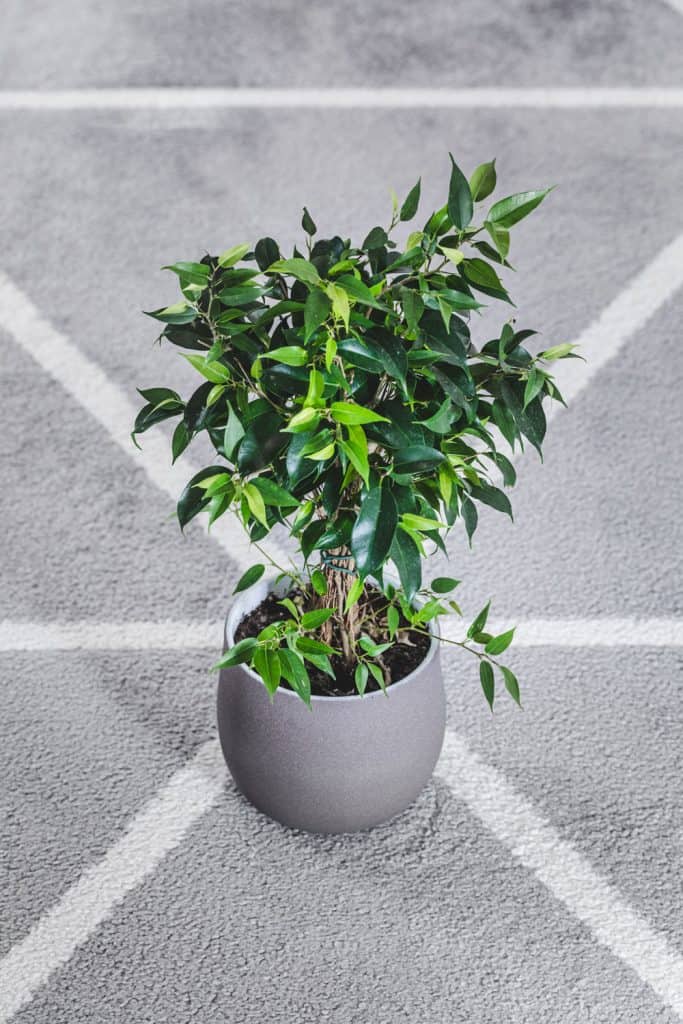Ficus benjamina, commonly referred to as a weeping fig tree, is often implemented as a potted tree for house decor purposes. The braided trunk and sage green pear-shaped leaves add an earthy yet sophisticated aesthetic paired with the practicality of creating oxygen for your home. Do these lovely trees provide more than aesthetic appeal? Continue reading to find out.
Yes, weeping fig trees do bear fruit. The small figs look similar to a traditional berry in color and size. The small pear-shaped figs range in color from black, green, orange, purple/lavender, red, and yellow. Although these figs are classified as non-toxic, they are considered inedible from their bitter taste and small size. Although, some enjoy the bitter flavor and add these small figs to their baked goods and smoothies. Indoor weeping figs will not produce fruit because the tree must be outdoors and pollinated by bees to grow figs/fruits.
Curious about how to care for one of these beautiful trees in your home properly? We've researched this topic and have quality results to share with you. Continue reading to develop a greater understanding of the weeping fig tree!

Can you eat weeping fig fruit?
According to the Minnesota Department of Health, the berries/figs are considered non-toxic to humans. Although the small berries are non-toxic, most consider these figs to be inedible due to their extremely bitter taste and small size. Only trees grown outdoors will produce fruit. All indoor weeping figs will not produce fruit and are mainly decorative. However, their foliage will help remove allergens and pollutions from the air in your home.
How do you eat ficus fruit?
Do contact a trained specialist before ingesting any fruits from a fig tree if you are unsure which tree species it may be. There are nearly 800 species of fig trees, and many look similar. Always exercise caution when deciding to ingest anything from a ficus tree.
Wash the fruit thoroughly with cold water. Dry the figs with a paper towel or dry kitchen towel. The figs could be dried in a food dehydrator and stored for use at a later date. Another option would be to consume the figs fresh. After washing, cut the figs in half and add to baked goods, oatmeal, porridge, or smoothies.
A word of caution
Do not consume the figs until the fruits are fully ripened. The unripened figs will have small droplets of sap that are considered to be slightly poisonous. The sap does cause itching, rashes, and in some cases, upset stomachs. If ingested, and these issues arise-- seek medical advice or attention.

Are Ficus Benjamina leaves edible?
The ficus benjamina leaves are not edible. A poisonous sap within the leaves and stems will cause mild itching and a rash. Children are more susceptible than adults to the sap and should always be monitored when in contact with the foliage of the trees. Pay special attention especially during the spring and summer months when the tree's sap content is at its highest levels.
The leaves are also toxic to cats and dogs. Suppose your pets ingest the sap via eating a leaf or chewing on the stems. This interaction could result in vomiting or diarrhea. If you think your pet may have ingested a toxic substance, contact your veterinarian or poison control.
What are the berries on my ficus tree?
Ficus benjamina does produce small black, green, orange, purple/lavender, red, and yellow figs that look similar to a traditional pear-shaped berry or small fig. These are a natural part of the tree's reproduction process. Indoor trees won't produce berries because the trees must be outside with exposure to pollinators to produce figs.
How do you look after a weeping fig tree?

According to Clemson College of Agriculture, Forestry, and Life Sciences, successfully caring for your lovely indoor weeping fig tree requires placing it where the tree has ample sunlight and warmth. Weeping figs thrive in bright indirect sunlight or filtered sunlight.
Some trees can tolerate direct sunlight for up to six hours per day if the humidity levels are high. Daytime temperatures of 75 to 85° F and evening temperatures ranging from 65 to 70° F are the best for facilitating continual growth and sustained health. Read more here: How Much Light Does A Weeping Fig Need?
Be mindful of keeping the soil evenly moist, and allow the tree to have dry soil in between waterings during the winter months. Also, do not let water stand in the tree's saucer; this will allow the roots to become waterlogged, negatively impacting the tree's health by causing root rot.
Wash the leaves with warm water and a small towel periodically to help the leaves absorb sunlight and improve cellular turnover. Also, administer plant fertilizer every four to eight weeks for added nutrition. Potted trees lack exposure to naturally occurring minerals in the soil and must absorb nutrition from a manufactured source. Consider adding a reminder in your calendar to remember the fertilization schedule continually.
Click here to view a Ficus Benjamina plant fertilizer at Amazon.
Tips and suggestions for maintaining a healthy weeping fig
Avoid moving the weeping fig tree. These trees acclimate to where they are in your home and struggle to reacclimate after moving. The tree may "leaf drop" after moving and lose many if not most of its leaves. This shows the tree is distressed or having nutritional or insect issues. Leaf drop is a natural part of the cycle of life for trees. However, when this occurs outside of the fall season, it is a cause for concern for the plant owner.
Also, avoid repotting, unless necessary. With the disruptive nature of repotting, the fig tree is more susceptible to disease and root issues.
Ficus fig trees originated in Asia and Australia, where the climate is quite humid most of the year, hence why these trees love humidity. One could purchase a humidifier to keep in the room where the tree is located. This is helpful during the winter months to combat dryness.
Click here to view a humidifier at Amazon.
Pruning the weeping fig is an essential part of caring for the tree. Avoid pruning healthy trees during the fall and winter months, and only prune late-spring or early summer to facilitate growth. Moreover, if the tree has sudden leaf drop or is infiltrated with insects, pruning the affected areas will help remedy those issues.
Safety considerations

The sap in the weeping fig is toxic for cats and dogs. Only bring one of these trees into your home if you are certain that your pet will not try to eat the stems or leaves-- or place it where your pets cannot access the tree.
Also, for those with small children, be certain to either safeguard the tree from your child or wait until the child is further along in life and has surpassed the stage of placing foreign objects in their mouths before adding a weeping fig to your decor. If you believe your child has had an adverse reaction to the weeping fig tree, call 911 or poison control immediately.
In closing
Keeping household plants provides a rewarding pastime that will certainly improve air quality in your home. Do practice solid safety standards for yourself, children, and your pets before deciding to bring home a new weeping fig. All of us at Garden Tabs hope you have found this article helpful. Please visit GardenTabs.com soon for more quality content and inspiration!



My weeping fig grown indoors bears figs twice a year without a pollinator this is in the uk